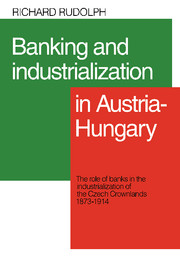 Banking and Industrialization in Austria-Hungary
Banking and Industrialization in Austria-Hungary Book contents
- Frontmatter
- Contents
- List of tables and charts
- Preface
- Abbreviations
- Introduction
- 1 Industrial development in the Austro-Hungarian Monarchy 1873–1914
- 2 Industrialization in the Czech Lands
- 3 Evolution of the financial structure
- 4 The relationship of banks to industry: the Viennese Great Banks
- 5 The relationship of banks to industry: the Czech banks
- 6 Sources of industrial credit
- 7 The role of the banks
- Appendixes
- Notes
- Select bibliography
- Index
7 - The role of the banks
Published online by Cambridge University Press: 05 January 2012
- Frontmatter
- Contents
- List of tables and charts
- Preface
- Abbreviations
- Introduction
- 1 Industrial development in the Austro-Hungarian Monarchy 1873–1914
- 2 Industrialization in the Czech Lands
- 3 Evolution of the financial structure
- 4 The relationship of banks to industry: the Viennese Great Banks
- 5 The relationship of banks to industry: the Czech banks
- 6 Sources of industrial credit
- 7 The role of the banks
- Appendixes
- Notes
- Select bibliography
- Index
Summary
The question of the extent of participation by the banks in industry revolves around both the question of the banks as initiators of development (their entrepreneurial and promotional role) and as lenders (their normal banking role). The first role has been brought into question by the major part of this study. The generally accepted view of the great central European banks as the entrepreneurial force which replaced government or individual activity in developing industry does not appear to be substantiated. In regard to Austrian banks, the picture presented here has been one of great caution on the part of the credit institutions in the area of risk capital. It is worth quoting what a leading financial journal had to say on this matter in late 1898:
The Austrian banks need a rejuvenation in both wood and sap. The financial personnel must be refreshed with an infusion of new blood, for it is not advancing with the times. The Bohemian coal mines are overwhelmed with orders, and the boom which has been going on for years without interruption has not left a trace on most institutes. Brüx was discovered by the Er-langer House in Frankfurt and is presently owned by a coal trader in Aussig. This ore millionaire ships more than a thousand car-loads abroad daily, perhaps also sending his bills of exchange to Vienna, but, nevertheless, must continually carry the risk of his financial plans alone. Bohemian coal has become a hallmark of European trade; it comes to Hamburg and penetrates to Switzerland, but the Viennese institutes stand detached with regard to it. […]
- Type
- Chapter
- Information
- Banking and Industrialization in Austria-HungaryThe Role of Banks in the Industrialization of the Czech Crownlands, 1873–1914, pp. 184 - 200Publisher: Cambridge University PressPrint publication year: 1976
